Table of Contents
A verb phrase is a group of words that includes a main verb and its helping verbs, working together to express an action or state. It plays a key role in sentence structure by providing detailed meaning and clarity.
Understanding verb phrases helps in forming correct sentences and improving fluency in English communication, making them essential for both writing and speaking.
What is a Verb Phrase?
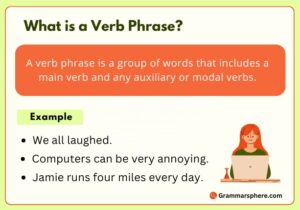
A verb phrase consists of a main verb and one or more helping (auxiliary) verbs. It expresses an action or state, often indicating tense or mood.
Examples:
She is reading a book. (Present continuous action)
They have finished their project. (Completed action)
He will be attending the meeting. (Future action)
Structure of a Verb Phrase
Definition of Verb Phrase
A verb phrase is a group of words that includes a main verb and one or more helping (auxiliary) verbs. It functions as a single verb in a sentence and helps express tense, mood, or voice.
(has been = helping verbs, studying = main verb)
Components of a Verb Phrase
A verb phrase consists of two main parts:
1. Main Verb
- The most important verb in the phrase that shows the main action or state.
- Can be an action verb (run, write, eat) or a linking verb (is, seem, become).
2. Helping (Auxiliary) Verbs
- Used with the main verb to indicate tense, mood, or voice.
- Includes be verbs (is, am, are, was, were), have verbs (has, have, had), do verbs (do, does, did), and modals (can, could, may, might, must, shall, should, will, would).
Examples of Verb Phrases:
- She is singing a song. (is = helping verb, singing = main verb)
- They have completed their work. (have = helping verb, completed = main verb)
- He should be sleeping by now. (should be = helping verbs, sleeping = main verb)
Verb Phrase vs Verbal Phrase
A verb phrase consists of a main verb and one or more auxiliary verbs. It expresses actions or states and often indicates tense, mood, or aspect.
The verb phrase can contain auxiliary verbs like is, have, will, along with the main verb. It describes actions or states happening in the present, past, or future.
- She is running. (Present continuous)
- They have completed the task. (Present perfect)
- I will call you tomorrow. (Future)
Verbal Phrase
A verbal phrase is a phrase that includes a verb, but the verb acts as a noun, adjective, or adverb. It does not act as the main action of the sentence.
Verbal phrases can be in the form of gerunds, infinitives, or participles. They are often used as subjects, objects, or modifiers, rather than describing an action directly.
- Swimming in the ocean is fun. (Gerund phrase acting as a subject)
- I want to learn Spanish. (Infinitive phrase acting as the object)
- The barking dog woke me up. (Participle phrase acting as an adjective)
How Do You Identify a Verb Phrase?
A verb phrase consists of a main verb and one or more auxiliary (helping) verbs. It shows the action, state, or condition in the sentence and often reflects the tense, mood, or aspect of the action.
To identify a verb phrase, look for the main verb and any helping verbs. These helping verbs could include words like is, are, have, will, can, etc. The verb phrase expresses the action or state of the subject in the sentence.
Steps to Identify a Verb Phrase:
- Find the main verb.
- Look for any auxiliary verbs that modify the main verb.
- The group of verbs together forms the verb phrase.
Examples:
- She is singing.
(Main verb: singing, auxiliary verb: is → Verb phrase: is singing) - They have been waiting.
(Main verb: waiting, auxiliary verbs: have and been → Verb phrase: have been waiting) - I will go to the store.
(Main verb: go, auxiliary verb: will → Verb phrase: will go)
Want to learn more about verbs? Click here to explore linking verbs, helping verbs, phrasal verbs, and more!
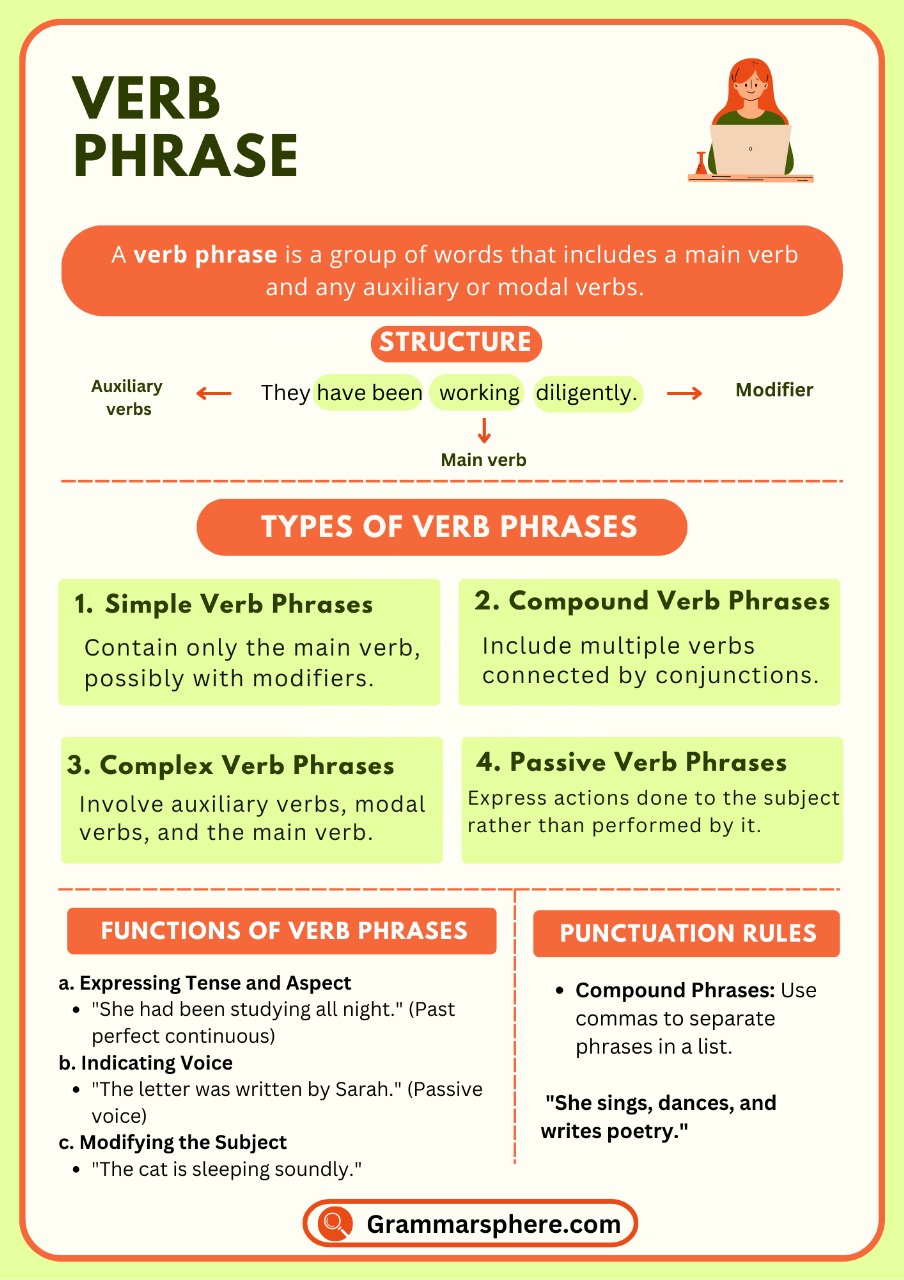
Types of Verb Phrases
1. Simple Verb Phrases
A simple verb phrase consists of only a main verb with no auxiliary verb. It is the basic form of a verb phrase and usually indicates an action or state.
- She runs every morning.
In this sentence, runs is the main verb, and there is no auxiliary verb.
2. Compound Verb Phrases
A compound verb phrase includes two or more auxiliary verbs that work together with the main verb to form a complete thought. Compound verb phrases often express different tenses or aspects like continuous or perfect actions.
- She has been studying for hours.
In this example, has been studying is a compound verb phrase, formed by the auxiliary verbs has and been along with the main verb studying.
3. Progressive Verb Phrases
A progressive verb phrase indicates an action that is ongoing or continuous. It combines a form of the verb to be with the main verb’s -ing form. This type of verb phrase shows that the action is happening at the moment or over time.
- They are playing soccer right now.
In this sentence, “are playing” is a progressive verb phrase, showing the action is happening in the present.
4. Perfect Verb Phrases
A perfect verb phrase indicates a completed action in relation to another time or event. It uses a form of the verb to have along with the past participle of the main verb. Perfect verb phrases show actions that have been completed in the past or have relevance to the present.
- I have finished my homework.
Here, have finished is a perfect verb phrase, indicating the action of finishing the homework is complete.
5. Perfect Progressive Verb Phrases
A perfect progressive verb phrase combines the elements of both the perfect and progressive aspects. It shows an action that was ongoing in the past and has now been completed, or an action that began in the past and continues to the present. It uses a form of to have plus been and the -ing form of the main verb.
- She has been working for five hours.
In this sentence, has been working is a perfect progressive verb phrase, showing an action that started in the past and is still ongoing.
6. Modal Verb Phrases
A modal verb phrase includes a modal verb (such as can, could, will, would, may, might, must, shall, should) and a main verb. It expresses possibility, necessity, permission, or ability.
- He can swim very fast.
Verb Phrase Rules
A verb phrase consists of a main verb and one or more auxiliary (helping) verbs. It works together to express an action, occurrence, or state of being while providing additional details like tense, mood, and aspect. Let’s go through the essential rules one by one.
1. Main Verb and Auxiliary Verbs Work Together
A verb phrase always contains a main verb, which conveys the primary meaning of the action or state, and one or more auxiliary verbs, which help complete the meaning by showing tense, mood, or aspect.
- She has been studying.
In this example, studying is the main verb, while has and been are auxiliary verbs. Together, they form the verb phrase.
2. Verb Phrases Show Time (Tense)
Verb phrases are used to show when an action takes place, whether it is in the past, present, or future. The auxiliary verb(s) in the phrase indicate the tense of the action.
- He will go to the market.
Here, will is an auxiliary verb that shows the action is in the future tense.
3. Use Verb Phrases to Show Progression or Continuous Action
In continuous or progressive tenses, auxiliary verbs like “is,” “are,” “was,” or “were” combine with the main verb to indicate an ongoing or continuous action.
- They are reading the book.
In this example, are is an auxiliary verb, and it shows the continuous aspect of the action (present continuous tense).
4. Verb Phrases Can Express Conditions or Possibilities
Verb phrases can express conditions or possibilities using modal auxiliary verbs like can, could, would, or might. These verbs show potential actions or situations that depend on a condition or are uncertain.
- I might go to the party later.
Here, might is a modal verb showing the possibility of an action.
5. In Negative Sentences, Use the Auxiliary Verb with “Not“
To create a negative verb phrase, add not after the auxiliary verb. This helps to negate the action or state.
- She has not finished her work.
In this case, has not forms the negative verb phrase, indicating that the action has not been completed.
Common Mistakes in Using Verb Phrases
Understanding verb phrases is essential, but many beginners make mistakes when using them. Here are some common errors and how to correct them:
1. Using the Wrong Helping Verb
❌ She have gone to the market.
✅ She has gone to the market.
(“Has” should be used with singular subjects, not “have.”)
2. Incorrect Verb Form in a Verb Phrase
❌ They was playing outside.
✅ They were playing outside.
(“Was” is singular, but “They” is plural, so “were” should be used.)
3. Missing a Helping Verb
❌ She going to the store.
✅ She is going to the store.
(A present continuous verb phrase needs “is,” “am,” or “are.”)
4. Overusing Helping Verbs
❌ He did went to school.
✅ He went to school.
(“Did” is not needed when the main verb is already in past form.)
5. Incorrect Order of Words in a Verb Phrase
❌ She can to go now.
✅ She can go now.
(“Can” is a modal verb and should be followed by the base form of the verb.)
6. Using a Past Form After a Modal Verb
❌ He must went home early.
✅ He must go home early.
(Modal verbs are followed by the base form, not the past tense.)
Example Sentences with Verb Phrase
- She is reading a book right now.
- They have been working on the project all day.
- I will visit my grandparents next weekend.
- He has finished his homework.
- We were playing football when it started raining.
- They can speak three languages fluently.
- She is going to the market later.
- I had seen the movie before.
- He might join us for dinner tonight.
- We are learning English grammar in class today.
FAQs
What is a verb phrase with examples?
A verb phrase is a combination of a main verb and one or more auxiliary (helping) verbs that together express an action, condition, or state.
Examples:
She is running.
They have finished their work.
What is a phrasal verb with example?
A phrasal verb is a combination of a main verb and one or more particles (prepositions or adverbs) that change the meaning of the original verb.
Examples:
Look up (to search for information).
I need to look up the word in the dictionary.
Give up (to quit).
She decided to give up after many attempts.
What are 10 Examples of Phrases?
In the morning
On the table
At the park
Under the weather
Out of control
With my friends
In front of the house
By the river
On the way
For a while
What is an example of a complete verb phrase?
A complete verb phrase consists of a main verb along with one or more auxiliary verbs, working together to express a complete action or state.
Example:
She has been studying all day.
In this sentence, “has been studying” is the complete verb phrase, with “has” and “been” as auxiliary verbs and “studying” as the main verb.
You May Also Like

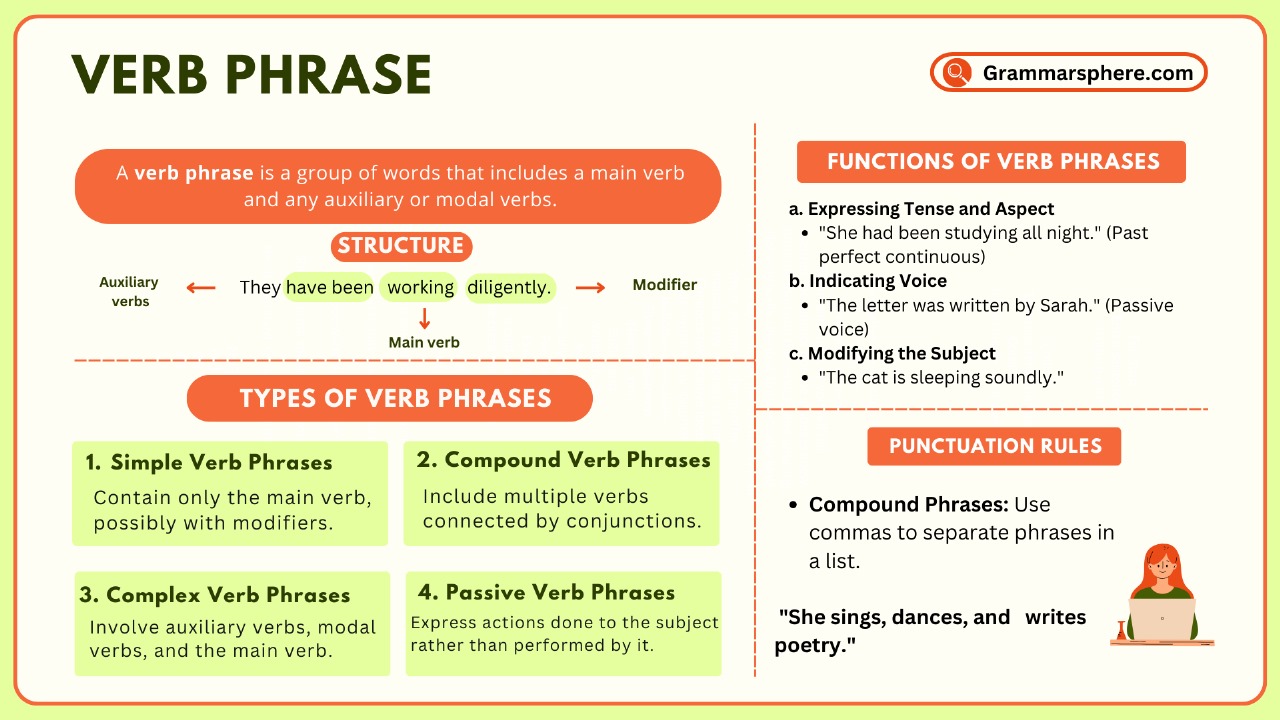
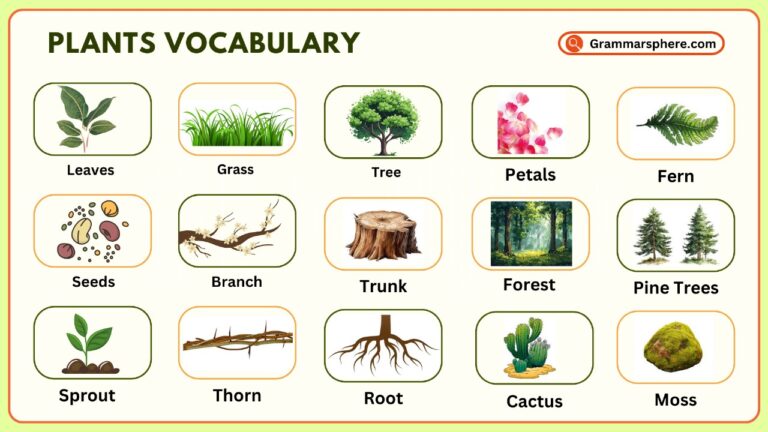
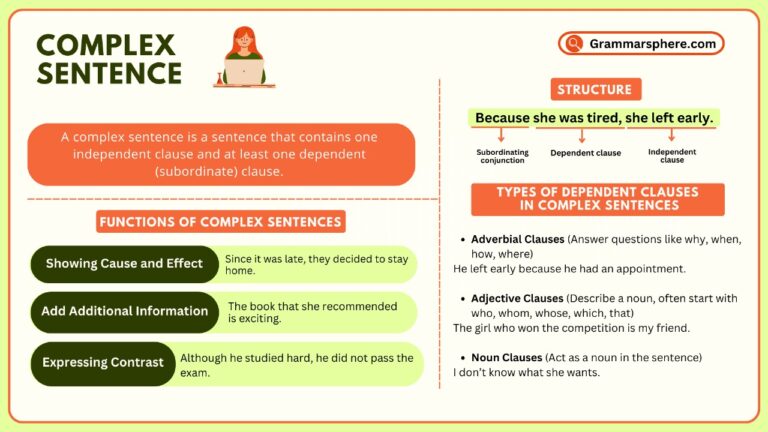
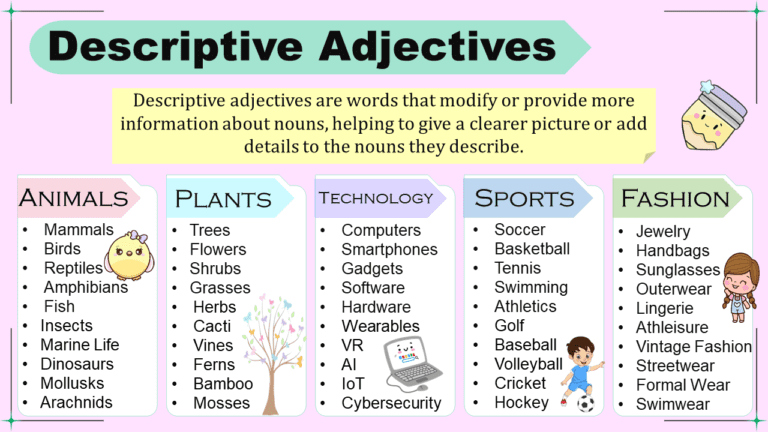
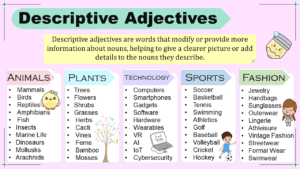
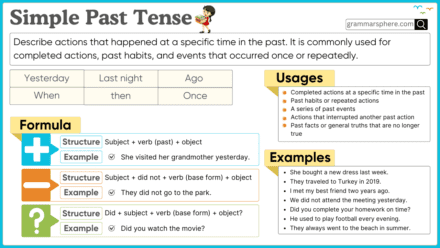
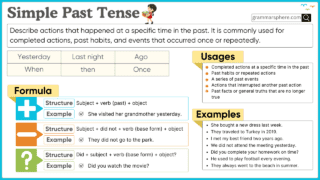
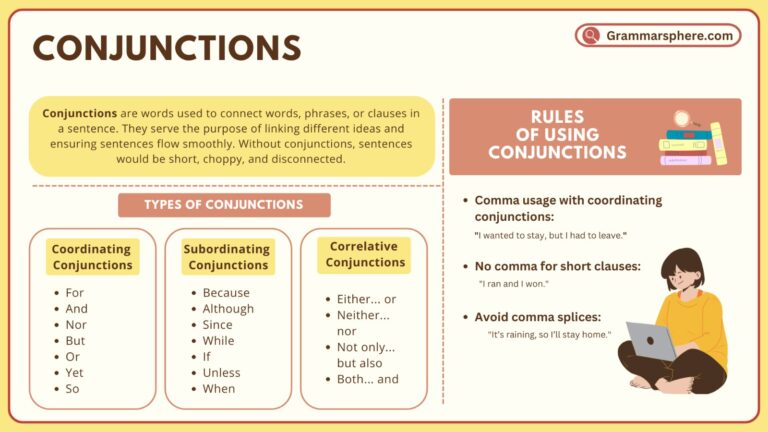
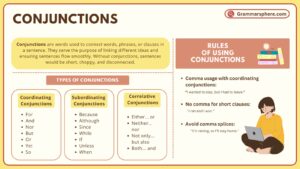
Leave a Comment